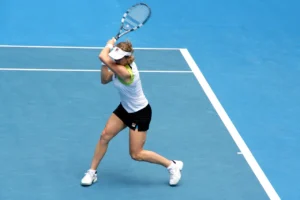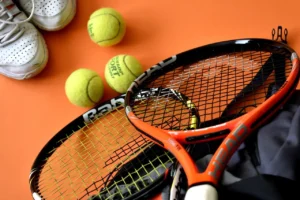Footwork is crucial in tennis. Quick and efficient movement on the court separates an average player from an exceptional one. It also helps players position themselves perfectly for each shot, whether a blistering forehand down the line or a delicate volley at the net.
Effective footwork can transform your game, enhancing your ability to cover the court, maintain balance, and execute accurate shots. Mastering essential stances and movement patterns can help you outmanoeuvre opponents, reduce unforced errors, and improve consistency. Let’s explore some practical footwork tips to help you become quicker, more agile, and more strategic on the court.
Mastering the Basics of Tennis Footwork
Essential Stances and Steps
Understanding the basics of footwork is essential for building a strong tennis game. Here are the foundational stances and steps every player needs to know:
- Ready Position:
- Stand with your feet shoulder-width apart, knees slightly bent, and weight on the balls of your feet.
- Hold the racquet in front of your body with both hands, staying balanced and alert for the next shot.
- Split Step:
- A quick hop performed just before the opponent strikes the ball, helping you stay balanced and ready to move in any direction.
- Focus on timing this step to coincide with your opponent’s shot, ensuring a quicker reaction time.
- Side Shuffle and Cross Step:
- Side Shuffle: Move sideways with your feet parallel and your body facing the net, keeping low and balanced. This exercise is ideal for covering short distances.
- Cross Step: Cross one leg over the other for quicker movement when covering more ground. This step is crucial for reaching wide shots or repositioning quickly.
- Recovery Steps:
- After hitting a shot, use small, quick steps to return to the ready position, ensuring you’re prepared for the next ball.
- Focus on maintaining balance and keeping your body centred while moving back.
Practising these essential stances and steps can dramatically improve your court coverage and help you maintain control during matches. Developing solid footwork patterns makes you quicker and more efficient, ultimately leading to more consistent and accurate play.
Drills to Improve Quickness on Court
Speed and Agility Exercises
Speed and agility are crucial for effective court coverage. Include these drills into your training routine to enhance quickness and coordination:
- Ladder Drills:
- High Knees: Step quickly through the rungs of an agility ladder, lifting your knees as high as possible with each step.
- In-and-Out Movement: Step both feet inside a ladder rung and then outside, moving sideways through the ladder.
- Side Steps: Face sideways and move both feet in and out of each rung in a shuffling motion.
- Training Tip:
- Perform each ladder drill for 30 seconds, repeating three times with 20-second rest intervals.
- Cone Drills:
- Triangle Drill: Set up three cones in a triangle shape. Run to each cone using side shuffles, forward sprints, and backward runs.
- T-Drill: Arrange cones in a T-shape. Sprint forward to the centre cone, shuffle left, shuffle right, and then backpedal to the starting point.
- Training Tip:
- Repeat each cone drill 3-4 times, resting for 30 seconds between sets.
- Shadow Tennis:
- Simulate playing points without a ball, focusing on movement patterns like split steps, side shuffles, and sprinting to the net.
- Incorporate forehand and backhand footwork, moving towards where the ball would typically be.
- Training Tip:
- Perform shadow tennis for 10-15 minutes, concentrating on perfecting each movement.
Regularly practising these drills can significantly improve your speed, agility, and overall court movement, helping you reach shots faster and execute more accurately.
Strengthening Techniques for Better Mobility
Leg Strength and Endurance
Building leg strength is crucial for better mobility and endurance on the tennis court. Here are some strength training exercises that’ll help improve footwork and stamina:
- Lunges and Squats:
- Lunges: Perform forward and lateral lunges to strengthen quads, hamstrings, and glutes.
- Forward Lunge: Step forward with one leg and lower your hips until both knees are bent at 90 degrees.
- Lateral Lunge: Step to the side with one leg and lower your hips, keeping the other leg straight.
- Squats: Include regular and jump squats to build explosive power for quick movements.
- Regular Squat: Stand with feet shoulder-width apart, lower your hips, and then rise back up.
- Jump Squat: Perform a regular squat but jump explosively at the end.
- Lunges: Perform forward and lateral lunges to strengthen quads, hamstrings, and glutes.
- Training Tip:
- Go for 3 sets of 10-15 repetitions for each exercise.
- Plyometric Exercises:
- Box Jumps: Jump onto a sturdy box or platform, focusing on landing softly.
- Burpees: Perform a squat, kick your feet back into a push-up position, then return to the squat and jump up.
- Training Tip:
- Include 3 sets of 8-10 repetitions for each plyometric exercise.
- Resistance Band Training:
- Side Steps: Place a resistance band around your ankles and take small, controlled steps to the side.
- High Knees: Keep the resistance band around your ankles and march in place, lifting your knees high.
- Training Tip:
- Perform each exercise for 1-2 minutes with a 30-second rest in between.
Strengthening your legs with these exercises contributes to better balance, quicker directional changes, and enhanced endurance, ensuring you stay mobile and competitive throughout the match.
Strategies for Anticipating the Ball
Reading Plays and Reacting
Anticipating your opponent’s shots and reacting swiftly can give you a significant edge on the court. Here’s how to improve your anticipation skills:
- Visual Cues:
- Body Positioning: Observe your opponent’s stance and body angle. An open stance often signals a cross-court shot, while a closed stance indicates a down-the-line shot.
- Racquet Angle: Note the racquet face during the backswing. A more closed racquet face suggests a topspin shot, while an open face indicates a slice or lob.
- Non-Dominant Hand: Watch the non-dominant hand, as it often points in the direction of the intended shot.
- Court Positioning:
- Recover to the Centre: After hitting a shot, recover quickly to the centre of the baseline or the appropriate spot for net play, ensuring better coverage of the court.
- Opposite Side Anticipation: Position yourself slightly to the opposite side of where your last shot landed. If you hit cross-court, be ready for a down-the-line response and vice versa.
- Developing Intuition:
- Pattern Recognition: Identify patterns in your opponent’s play style, such as preferred shots, and use them to anticipate future plays.
- Practice Matches: Play practice matches focusing solely on reading and reacting to your opponent’s shots rather than winning points.
- Match Footage Analysis: Watch professional matches to learn from their shot anticipation techniques and apply them to your game.
By honing your ability to read visual cues, position strategically, and develop intuitive plays, you can significantly improve your reaction times and outmanoeuvre opponents with more effective footwork.
Maintaining Footwork Efficiency During Matches
Consistency Under Pressure
Maintaining effective footwork during high-pressure matches is crucial for consistent performance. Here’s how to stay focused and efficient when the stakes are high:
- Routine and Preparation:
- Pre-Match Warm-Up: Establish a warm-up routine that includes split steps, side shuffles, and shadow tennis to activate footwork muscles and prepare mentally.
- Visualisation Techniques: Visualise perfect footwork movements before the match starts, reinforcing positive patterns.
- Mental Focus:
- Stay Present: Focus on one point at a time. Avoid dwelling on previous points or worrying about future plays.
- Positive Self-Talk: Encourage yourself with phrases like “keep moving” or “stay balanced” to maintain concentration and rhythm.
- Deep Breaths: Take deep breaths between points to calm your nerves and refocus your mind.
- Consistency in Technique:
- Split Steps: Perform a split step before each shot to keep you balanced and ready for quick movement.
- Recovery Steps: After hitting a shot, use recovery steps to return to your optimal court position swiftly.
- Footwork Patterns: To minimise errors, stick to familiar footwork patterns like side shuffles, cross steps, and backpedals.
- Post-Match Analysis:
- Match Footage Review: Review match footage to identify areas where footwork faltered under preassure.
- Practice Drills: Incorporate drills that target weak points identified in your review.
Maintaining mental focus and a consistent footwork technique, even in high-pressure situations, will help you stay balanced and responsive, giving you an edge over opponents.
Step Up Your Tennis Game with Effective Footwork
Footwork is the foundation of tennis success. Mastering the basics, practising agility drills, and developing anticipation strategies can significantly enhance your gameplay. By building leg strength and maintaining consistent technique under pressure, you’ll move more efficiently on the court and outplay your opponents.
If you’re ready to elevate your tennis skills, trust Evolve Tennis Academy to help refine your footwork and transform your game. Our expert coaches will guide you through effective training routines that deliver tangible improvements.
Contact Evolve Tennis Academy today and take your tennis performance to the next level with top-notch footwork techniques.





